
Shangdi (Chinese: 上帝; pinyin: Shàngdì; Wade–Giles: Shang4 Ti4), also called simply Di (Chinese: 帝; pinyin: Dì; lit. 'God'), is the name of the Chinese Highest Deity or "Lord Above" in the theology of the classical texts, especially deriving from Shang theology and finding an equivalent in the later Tiān ("Heaven" or "Great Whole") of Zhou theology.

Religion in China is diverse and most Chinese people are either non-religious or practice a combination of Buddhism and Taoism with a Confucian worldview, which is collectively termed as Chinese folk religion.
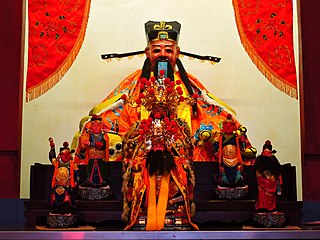
A City God, is a tutelary deity in Chinese folk religion who is believed to protect the people and the affairs of the particular village, town or city of great dimension, and the corresponding location in the afterlife. City God cults appeared over two millennia ago, and originally involved worship of a protective deity of a town's walls and moats. Later, the term came to be applied to deified leaders from the town, who serve in authority over the souls of the deceased from that town, and intervene in the affairs of the living, in conjunction with other officials of the hierarchy of divine beings. City Gods are considered above tudigongs, which themselves are above landlord deities.

Joss paper, also known as incense papers, are papercrafts or sheets of paper made into burnt offerings common in Chinese ancestral worship. Worship of deities in Chinese folk religion also uses a similar type of joss paper. Joss paper, as well as other papier-mâché items, are also burned or buried in various Asian funerals, "to ensure that the spirit of the deceased has sufficient means in the afterlife". In Taiwan alone, the annual revenue that temples received from burning joss paper was US$400 million as of 2014.
Taoism in Singapore is the religion of about 8.8% of the country's entire population as per the 2020 census. The definition of "Taoism" in the country is included as part of the wider Chinese folk religion. In general, nearly all adherents of Taoism in Singapore are associated with the mainstream Zhengyi school. Larger proportion of older residents adhere to Taoism, as compared with those in younger age groups.

Chinese folk religion comprises a range of traditional religious practices of Han Chinese, including the Chinese diaspora. This includes the veneration of shen ('spirits') and ancestors, and worship devoted to deities and immortals, who can be deities of places or natural phenomena, of human behaviour, or progenitors of family lineages. Stories surrounding these gods form a loose canon of Chinese mythology. By the Song dynasty (960–1279), these practices had been blended with Buddhist, Confucian, and Taoist teachings to form the popular religious system which has lasted in many ways until the present day. The government of China generally tolerates popular religious organizations, but has suppressed or persecuted those that they fear would undermine social stability.
Religion in Hong Kong is characterised by a multi-faith diversity of beliefs and practices.
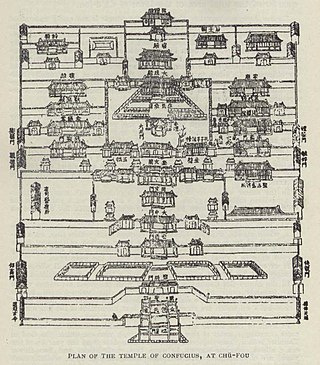
A temple of Confucius or Confucian temple is a temple for the veneration of Confucius and the sages and philosophers of Confucianism in Chinese folk religion and other East Asian religions. They were formerly the site of the administration of the imperial examination in China, Korea, Japan and Vietnam and often housed schools and other studying facilities.

Lotus Pond is an artificial lake and popular tourist destination on the east side of Zuoying District in Kaohsiung, Taiwan. Opened in 1951, it is famous for the lotus plants on the lake and the numerous temples around the lake, including the Spring and Autumn Pavilions (春秋閣), the Dragon and Tiger Pagodas (龍虎塔), and the Confucian Temple (孔廟).

Religion in Taiwan is characterised by a diversity of religious beliefs and practices, predominantly those pertaining to the continued preservation of the ancient Chinese culture and religion. Freedom of religion is inscribed in the constitution of the Republic of China (Taiwan). The majority of Taiwanese people practice a combination of Buddhism and Taoism often with a Confucian worldview, which is collectively termed as Chinese folk religion.

A spirit tablet, memorial tablet, or ancestral tablet is a placard that people used to designate the seat of a deity or past ancestor as well as to enclose it. The name of the deity or the past ancestor is usually inscribed onto the tablet. With origins in traditional Chinese culture, the spirit tablet is a common sight in many East Asian countries, where forms of ancestor veneration are practiced. Spirit tablets are traditional ritual objects commonly seen in temples, shrines, and household altars throughout mainland China and Taiwan.

An ancestral shrine, hall or temple, also called lineage temple, is a temple dedicated to deified ancestors and progenitors of surname lineages or families in the Chinese tradition. Ancestral temples are closely linked to Confucian philosophy and culture and the emphasis that it places on filial piety.

Vietnamese folk religion or Đạo Lương (道良) is a group of spiritual beliefs and practices adhered by the Vietnamese people. About 86% of the population in Vietnam are reported irreligious, but are associated with this tradition.
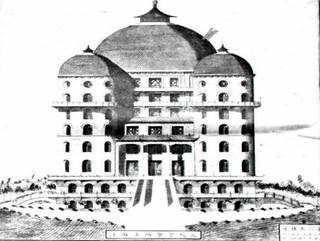
The Confucian church is a Confucian religious and social institution of the congregational type. It was first proposed by Kang Youwei (1858–1927) near the end of the 19th century, as a state religion of Qing China following a European model.
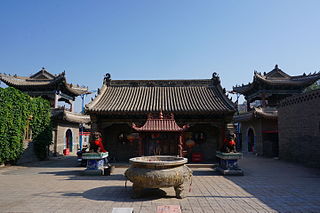
Northeast China folk religion is the variety of Chinese folk religion of northeast China, characterised by distinctive cults original to Hebei and Shandong, transplanted and adapted by the Han Chinese settlers of Liaoning, Jilin and Heilongjiang since the Qing dynasty. It is characterised by terminology, deities and practices that are different from those of central and southern Chinese folk religion. Many of these patterns derive from the interaction of Han religion with Manchu shamanism.

Chinese folk religion plays a dynamic role in the lives of the overseas Chinese who have settled in the countries of this geographic region, particularly Burmese Chinese, Singaporean Chinese, Malaysian Chinese, Thai Chinese, Indonesian Chinese and Hoa. Some Chinese Filipinos also still practice some Chinese traditional religions, besides Christianity of either Roman Catholicism or Protestantism, with which some have also varyingly syncretized traditional Chinese religious practices. Chinese folk religion, the ethnic religion of Han Chinese, "Shenism" was especially coined referring to its Southeast Asian expression; another Southeast Asian name for the religion is the Sanskrit expression Satya Dharma.

Religion in Inner Mongolia is characterised by the diverse traditions of Mongolian-Tibetan Buddhism, Chinese Buddhism, the Chinese traditional religion including the traditional Chinese ancestral religion, Taoism, Confucianism and folk religious sects, and the Mongolian native religion. The region is inhabited by a majority of Han Chinese and a substantial minority of Southern Mongols, so that some religions follow ethnic lines.
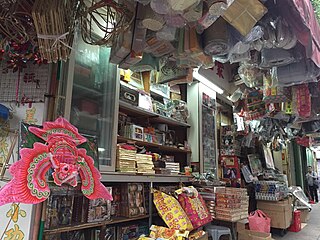
Zhizha, or Taoist paper art, is a type of traditional craft, mainly used as offerings in Taoist festive celebrations and funerals. It had become a widely accepted element in religious practice since Northern Song Dynasty. It now faces a gradual loss of craftsmanship due to related environmental concerns and weakened religious belief.

Chinese gods and immortals are beings in various Chinese religions seen in a variety of ways and mythological contexts.
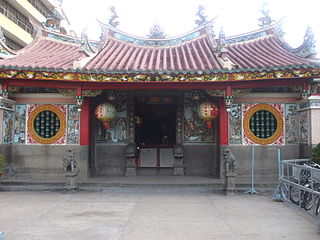
Miao (廟/庙) are buildings in traditional East Asian religions enshrining gods, myths or legends, sages of past dynasties, and famous historical figures. They are a kind of Chinese temple architecture and contrast with Ci Shrines which enshrine ancestors and people instead of deities.






















